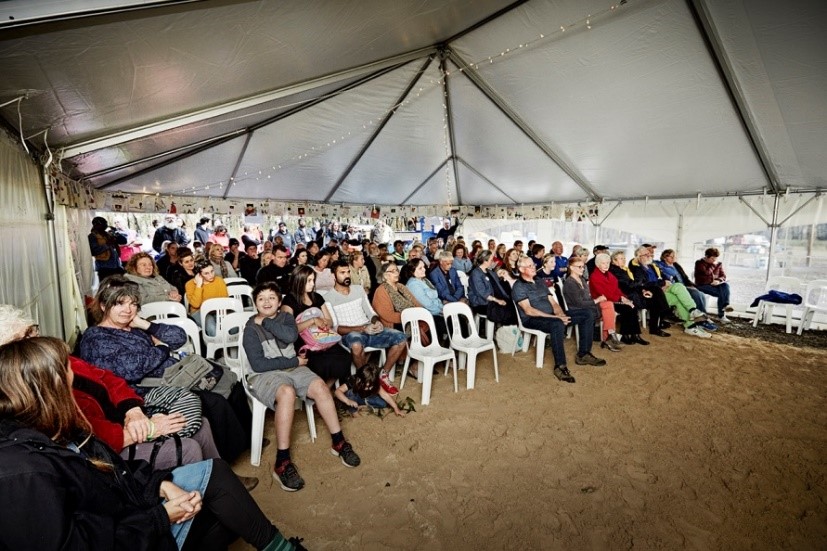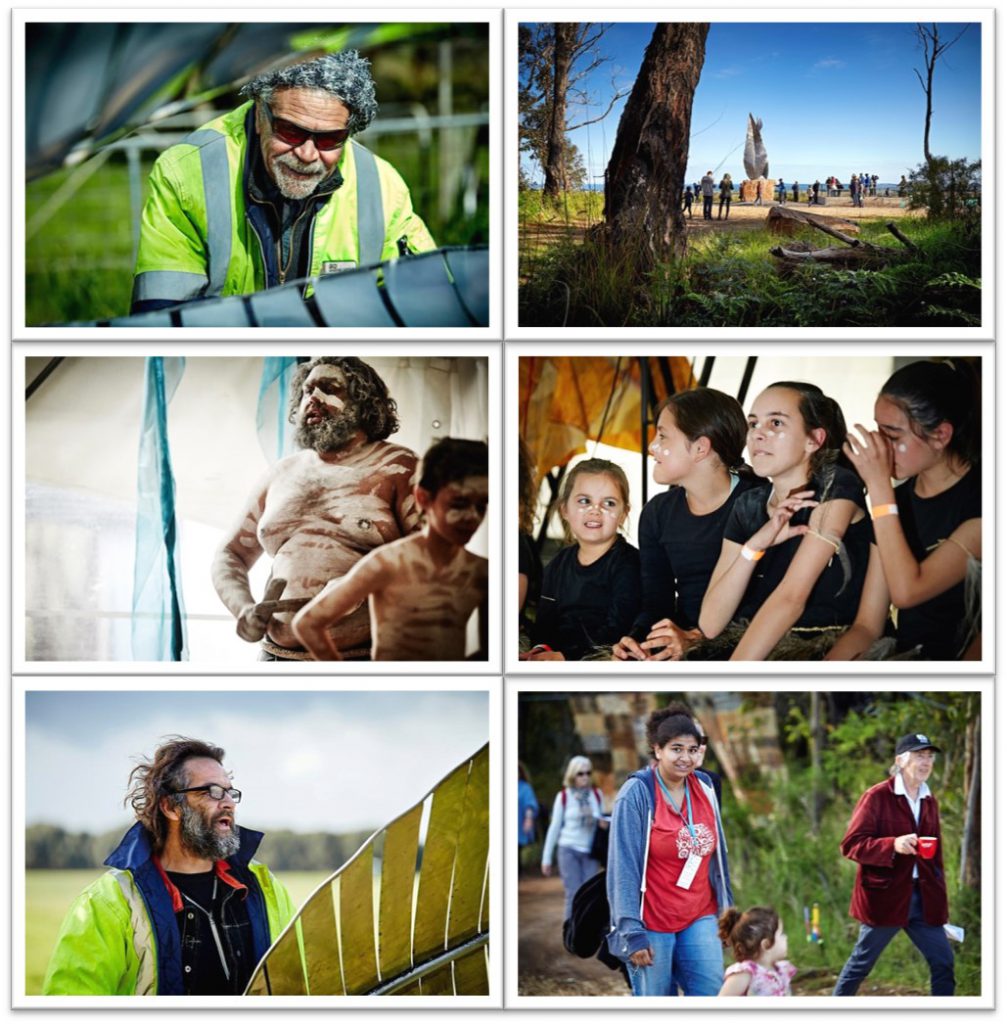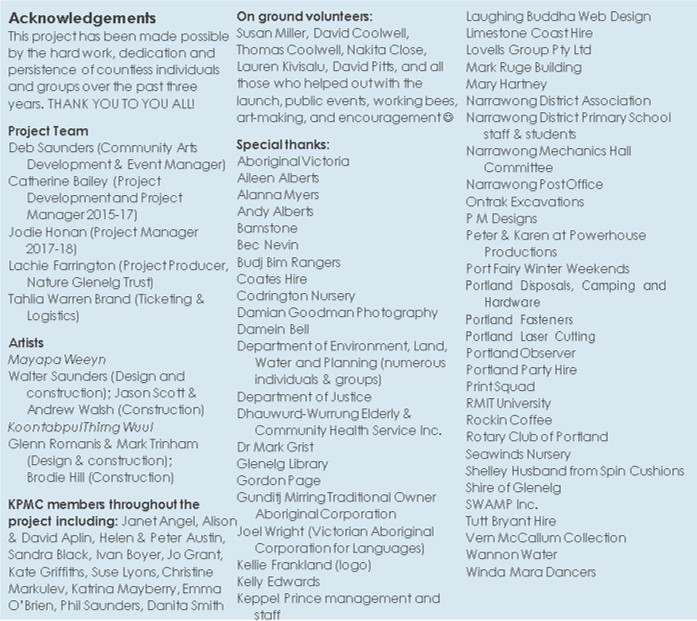From Mountain to Sea… The Kang-o-meerteek project celebrates the power of community, art, history and story-telling
On Saturday, 10th of November 2018, we celebrated community, art, history and the power of story-telling at a community event to celebrate the Kang-o-meerteek sculptures at Narrawong, Victoria. Over 140 people visited the two new sculptures and three years of dreaming, talking, designing, planning, digging, planting, and creating culminated in a community celebration in the Mt Clay State Forest.
Mayapa Weeyn (‘Make Fire’)
Pronunciation: MAYA – pah – WEE-YUN
The sculpture pays tribute to the Cart Gunditj and all fifty-nine clans of the Dhauwurd Wurrung. The design recalls the signal fires the Cart Gunditj lit to signal to other clans when whales beached. When non-Aboriginal whalers arrived, the fires were lit to signal a whale in the bay.

Mayapa Weeyn: designed and constructed by Walter Saunders, with construction assistance by Jason Scott and Andrew Walsh. Stainless steel and basalt. Photo by Damian Goodman
Koontabpul Thirng Wuul (‘Whale Sun Shadow’)
Pronunciation: KOON-TAB-pul – THIR-NG – wu-ul
Nestled beside the Surry River, Koontabpul Thirng Wuul includes a human sundial and four sculpted stone seats. The basalt seats that surround the sundial are based on Greystone, an unusual pale grey Southern Right Whale. The paving includes a map of the Portland Bay coast with markers for the two sculptures.

Koontabpul Thirng Wuul: designed and constructed by Glenn Romanis and Mark Trinham with construction assistance from Brodie Hill. Basalt, steel, sandstone. Photo by Damian Goodman
Community Art at the Launch
Down by the Surry River, Koontabpul Thirng Wuul was decorated with festive turquoise banners. A trail of small turquoise flags led like a breadcrumb trail from the Surry River, all the way up Boyers Road to the Sawpit Picnic area, then tantalisingly into the forest. As celebration attendees walked down the forest track, the sticks transformed into clusters of coloured stick wraps created by our tireless volunteers and local kids. A new discovery awaited at every turn, until encountering the magical curtains.
The eco-dyed silk curtains floated and twisted on the breeze, enticing children and big kids alike to play for a while before they finally met Mayapa Weeyn for the first time.
Opening Ceremony
The sleepy Sawpit Picnic area was transformed into a small festival site with marquee for the afternoon. Displayed around the perimeter of the marquee were flags representing the 59 clans of the Dhauwurd Wurrung language group which had been created by all 59 students of Narrawong District Primary School (how serendipitous that they were the same number!). A large photograph of members of the Dhauwurd Wurrung language group hung behind the stage.
The Winda Mara dancers welcomed everyone to the celebration, with Master of Ceremonies, Andy Govanstone.
After months of intense work, lead artist Walter Saunders spoke about the growth of the project from the seed of an idea to the final artwork at the Whalers Lookout.
Joel Wright, from Victorian Aboriginal Corporation for Languages, explained the meaning of the Dhauwurd Wurrung and Peek Wurrung languages words which were chosen for the project and the individual sculptures.
Representing the project administrator, Nature Glenelg Trust, Lachlan Farrington thanked all those who had helped, including representatives of Regional Arts Victoria who had travelled from Melbourne for the event, and the Narrawong community for getting behind the project.
The original song Cart Gunditj was composed for the project by Andy Alberts and Wal Saunders. This song, together with the two permanent artworks, and Powerhouse Productions’ film of the project (soon to be released for all to see!) will be legacies of the project. The event finished up with grooving tunes from south-west band Modus Vivendi. Thanks everyone who contributed their work and energy to creating and celebrating the project.
“Today is a chance for understanding,
but more importantly it’s about knowledge and appreciation,
particularly for the Cart Gunditj who are no longer with us.”
Walter Saunders
The Narrawong Kang-o-meerteek Small Town Transformation acknowledges the Cart Gunditj and Gilgar Gunditj who are the original custodians of the land on which this project takes place, and pays its respect to all past and present members of the Dhauwurd Wurrung Language Group and to all Aboriginal and Torres Strait Islander People.
The Kang-o-meerteek project was funded through the Regional Arts Victoria Small Towns Transformation program.




